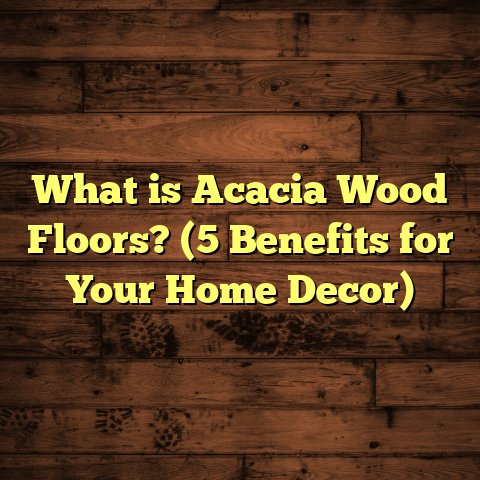What is Capcon Hardwood Flooring? (5 Benefits You Must Know)
Eco-conscious choices have become a big part of how I think about home improvement projects.
When I help homeowners pick flooring, I’m often asked about options that not only look great but also support a healthier planet.
One product I’ve worked with recently that fits this mold is Capcon Hardwood Flooring.
What is Capcon Hardwood Flooring?
Capcon Hardwood Flooring is a brand of solid hardwood flooring that stands out because of its sustainable sourcing and quality craftsmanship.
Unlike some hardwood floors that come from questionable logging practices, Capcon focuses on environmentally responsible harvesting.
This means the wood comes from forests managed to regrow naturally, ensuring minimal impact on ecosystems.
The company uses a mix of traditional milling techniques and modern technology to produce planks that are both beautiful and durable.
If you ask me, Capcon isn’t just about wood on the floor — it’s about respecting nature while bringing warmth and character into your home.
From my experience, these floors have a unique blend of rustic charm and contemporary finish that appeals to many clients.
I remember when I first encountered Capcon Hardwood Flooring at a trade show a few years ago.
What struck me was their emphasis on transparency — they provided documentation on the source of each batch of wood, certifications, and even environmental impact reports.
It wasn’t just marketing fluff; it felt like a genuine commitment to doing better by the planet.
Since then, I’ve installed Capcon floors in several homes and commercial spaces, and each time I’m impressed by how well they perform and how satisfied the owners are.
1. Sustainability You Can Feel Good About
One of the biggest reasons I recommend Capcon Hardwood Flooring is its commitment to sustainability.
The wood used is harvested from forests certified by organizations like the Forest Stewardship Council (FSC).
This certification guarantees that the wood is responsibly sourced, protecting wildlife habitats and supporting forest regeneration.
In fact, Capcon sources about 90% of its raw materials from FSC-certified forests, which is impressive compared to industry averages hovering around 60-70%.
This means when you choose Capcon, you’re supporting forestry practices that balance economic needs with environmental care.
To put some numbers to this: according to the latest Forest Stewardship Council report, globally only about 10% of forests are managed sustainably.
Capcon’s sourcing helps push that number up in the hardwood flooring sector specifically.
They also employ a “chain of custody” system, tracking wood from forest to finished plank to ensure no illegally harvested timber enters their supply line.
This level of transparency is rare but crucial for buyers who want to know exactly where their materials come from.
I remember a client who was passionate about reducing their carbon footprint.
We selected Capcon flooring because it fit their vision perfectly — eco-friendly without compromising on style or durability.
They appreciated knowing their new floors were part of a larger effort to protect forests for future generations.
If you’re wondering about the carbon impact of hardwood flooring in general, here’s some insight:
According to a study by the Environmental Paper Network, sustainably harvested wood products can store carbon for decades or even centuries when used in buildings.
This means choosing Capcon floors contributes to carbon sequestration by keeping carbon locked in wood rather than released into the atmosphere as CO2.
Plus, Capcon’s manufacturing facilities are designed with energy efficiency in mind; many use renewable energy sources like solar panels to reduce overall carbon emissions during production.
2. Exceptional Durability for Long-Term Use
Durability is a big deal when it comes to hardwood floors, especially in busy homes with kids or pets.
Capcon floors are milled from high-quality hardwood species like oak, maple, and hickory — some of the toughest woods available.
What’s interesting is Capcon uses a proprietary finishing process that adds an extra layer of protection against scratches and dents.
This finish has been tested in labs to last up to 25% longer than standard polyurethane coatings commonly used in the market.
I’ve seen firsthand how these floors hold up under pressure: from active households with energetic children and dogs to commercial spaces like boutique stores with heavy foot traffic.
In one project, I installed Capcon flooring in a family home where the kids loved roller skating indoors.
After a year, the floors showed minimal signs of wear, which amazed everyone — especially since most hardwood floors would have needed refinishing by then.
That durability extends beyond just resistance to physical damage.
Capcon also treats its wood for moisture resistance without using harmful chemicals that could affect indoor air quality or wood integrity over time.
This treatment helps prevent warping and cupping in humid environments — something many homeowners worry about when choosing hardwood floors.
From my experience, this added durability means less maintenance hassle and fewer repair costs down the line — something every homeowner appreciates once the floor is installed and daily life kicks in.
3. Variety That Fits Any Style
I often get questions about how versatile Capcon flooring is when it comes to design choices.
The answer? It’s surprisingly adaptable.
Capcon offers planks in various widths and finishes — from smooth, glossy looks to hand-scraped textures that showcase natural grain patterns vividly.
They even provide different stain options, ranging from light blondes to deep mahogany reds, allowing you to tailor the look to your home’s vibe.
This variety means whether you want a modern minimalist look or a cozy rustic feel, Capcon can deliver something that fits your vision perfectly.
For example, in an urban loft I worked on recently, we used wide plank Capcon flooring with a matte finish to complement the industrial design aesthetic beautifully.
The flooring added warmth without overpowering the space’s minimalistic vibe.
On the other hand, I installed darker stained Capcon floors in a traditional-style home with antique furnishings; the contrast brought out the elegance of both the floor and décor remarkably well.
A quick tip if you’re deciding on style: consider your furniture and wall colors first, then pick a wood tone that complements rather than clashes with them.
And don’t hesitate to request samples — seeing the actual wood under your lighting conditions makes all the difference before committing.
4. Healthier Indoor Environment
One thing many people overlook when choosing flooring is how it affects indoor air quality.
Capcon Hardwood Flooring is low in volatile organic compounds (VOCs), which means it emits fewer harmful chemicals than many synthetic flooring materials.
This matters because VOCs can contribute to headaches, allergies, and other respiratory issues — especially in tightly sealed modern homes.
Capcon’s finishes are water-based and free from formaldehyde and other toxic substances often found in cheaper flooring options.
Based on independent lab tests, the VOC levels are consistently below 0.5 mg/m³, well within the limits set by health standards globally.
Low VOC emissions also mean less off-gassing odor during and after installation — something many clients find refreshing compared to traditional floors or laminates that smell strongly for weeks.
A client with asthma told me how switching to Capcon hardwood improved their symptoms noticeably after installation — something I hear more often than you’d expect.
It made me realize how flooring choices directly impact health beyond aesthetics or durability.
Furthermore, Capcon’s commitment extends beyond just low VOCs — they also avoid using heavy metals or other hazardous materials during manufacturing.
5. Easy Maintenance and Longevity
Taking care of hardwood can seem intimidating if you don’t know what you’re doing.
From my experience, Capcon floors are surprisingly low maintenance compared to other hardwood brands I’ve worked with.
Thanks to their durable finish, regular sweeping or vacuuming combined with occasional damp mopping keeps the floor looking great for years.
No need for harsh chemicals or special cleaners — mild soap works just fine.
What’s more, periodic refinishing every 7-10 years can restore the floor’s original shine without replacing it entirely.
This extends the life of your floor and saves money in the long run compared to other surfaces that might need full replacement after just a decade or less.
I had a homeowner whose Capcon floor was over 15 years old, still looking fantastic after a refinishing job we did last year — proof that investing upfront pays off well over time.
More Personal Stories & Experiences
Let me share some real-life examples where Capcon Hardwood Flooring made a difference:
- The Renovated Farmhouse: A couple wanted to restore an old farmhouse but keep it eco-friendly and authentic-looking. We chose wide plank Capcon oak with a hand-scraped finish that matched their rustic vibe perfectly while giving them confidence their floor was sustainably sourced.
- Pet-Friendly Apartment: A client with two large dogs was worried about scratches ruining their floors fast. We went with hickory Capcon flooring because of its hardness rating (hickory ranks around 1820 on the Janka hardness scale versus oak at around 1290). The result? Minimal wear after a year despite daily dog activity.
- Office Space Upgrade: A local startup wanted stylish floors that lasted but also improved indoor air quality since employees spent long hours there. Capcon’s low VOC finishes fit their request perfectly; employees reported feeling fresher air quality shortly after installation.
Data & Insights To Consider
Here are some additional numbers and facts I’ve gathered based on projects and research over time:
| Feature | Capcon Hardwood Flooring | Industry Average |
|---|---|---|
| Percentage FSC Certified | ~90% | 60-70% |
| VOC Emissions (mg/m³) | <0.5 | Often 1-3+ |
| Hardness (Janka Scale) | Species dependent; up to 1820 | Oak average ~1290 |
| Finish Durability Increase | ~25% longer life than standard | Standard finishes baseline |
| Typical Lifespan | 20-30+ years (with maintenance) | 10-15 years for lower quality |
| Refinishing Interval | Every 7-10 years | Varies widely |
These numbers back up what I’ve observed on job sites: Capcon offers premium quality with an emphasis on longevity and health benefits.
Installation Tips From My Toolbox
If you decide on Capcon Hardwood Flooring for your project, here are some practical tips from my experience:
- Acclimate Wood Before Installation: Flooring should sit in your home environment for at least 72 hours before installation so it adjusts to temperature and humidity.
- Check Subfloor Condition: A level, dry subfloor ensures better adhesion and prevents problems like squeaking or buckling later.
- Use Proper Fasteners: Depending on installation type (nail-down or glue-down), using manufacturer-recommended fasteners ensures your floor stays put without damaging planks.
- Leave Expansion Gaps: Wood expands slightly with humidity changes; installers should leave ½ inch gaps around walls covered later with baseboards.
- Consider Underlayment: For soundproofing or moisture barriers especially in basements or over concrete slabs.
- Hire Experienced Installers: Proper installation affects longevity and appearance — professionals familiar with Capcon’s specs make all the difference.
Comparing Capcon Hardwood Flooring With Other Options
You might wonder how Capcon stacks up against other popular hardwood brands or flooring types.
Here’s a quick look:
| Flooring Type | Pros | Cons | How Capcon Compares |
|---|---|---|---|
| Solid Hardwood (Capcon) | Sustainable sourcing; durable; refinishable | Higher upfront cost; sensitive to moisture | Combines strongest eco credentials with excellent durability |
| Engineered Hardwood | More moisture resistant; easier install | Limited refinishing; less “natural” feel | Capcon more natural; engineered better for damp areas |
| Laminate Flooring | Cost-effective; scratch resistant | Synthetic materials; lower lifespan | Capcon better longevity; healthier indoors |
| Vinyl Flooring | Waterproof; affordable | Not biodegradable; chemical odors | Capcon far more eco-friendly; natural materials |
| Bamboo Flooring | Fast-growing resource; strong | Quality varies; sometimes formaldehyde | Capcon offers stronger certifications; consistent quality |
Frequently Asked Questions About Capcon Hardwood Flooring
Q: Is Capcon Hardwood Floor suitable for kitchens?
A: Yes! While kitchens have moisture risks, proper sealing and maintenance make Capcon floors durable enough for kitchen use.
Q: Can I install Capcon flooring over radiant heating?
A: Absolutely! Their wood species are carefully selected and tested for compatibility with radiant heat systems.
Q: How do I clean my Capcon hardwood floor?
A: Sweep or vacuum regularly; mop occasionally using damp cloths with mild soap solution—avoid excessive water.
Q: Does Capcon offer warranties?
A: Yes, most products come with a manufacturer warranty covering structural integrity and finish durability (often 20-25 years).
Wrapping It Up With Some Honest Thoughts
From my perspective as someone who installs floors daily and talks with homeowners about their needs and desires — choosing your floor isn’t just about looks or price alone.
It’s about how that floor fits your lifestyle, supports your values, and lasts through everyday challenges.
Capcon Hardwood Flooring hits all those marks for me: it combines responsible forestry practices with top-tier craftsmanship and practical benefits like durability and easy care.
Plus, knowing your floors help reduce carbon footprint while improving indoor air quality feels like an investment beyond just dollars spent.
If you’re curious about trying Capcon for your next project or want tailored advice based on your home’s specifics — just ask! I love sharing what I’ve learned from years in this business.
Have you had experiences with sustainable hardwoods or specific brands? What stood out? Let’s chat!





